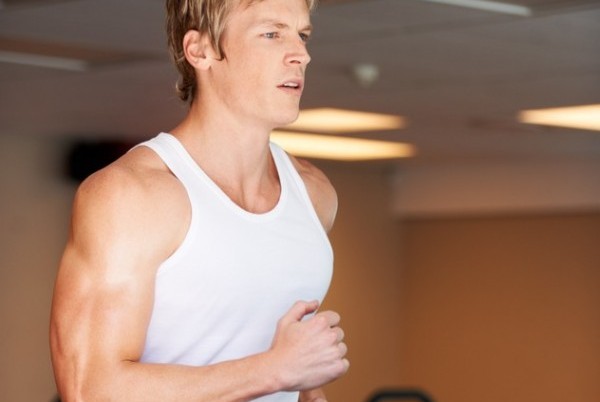Few gimmicks have helped sell more fitness tripe than the “afterburn effect.”
Marketers stumbled upon it decades ago and ever since have been using it to hawk books, magazines, supplements, workout programs, and the like.
It catches people’s attention because it sounds cool and just about anything that claims to give you a fat loss edge is alluring.
It even appears to have science on its side, and let’s face it–when we’re talking fat loss, even the most tenuous science-based arguments can pass muster. We just really want to believe.
Is the afterburn effect real, though? And if it is, can it actually help you lose fat faster?
Let’s find out.
Table of Contents
+
What is the Afterburn Effect?

The afterburn effect is simply additional energy expenditure that occurs after exercise.
The technical term is “excess post-exercise oxygen consumption” or EPOC, which clues you in as to what’s going on.
You see, after you work out, your body must perform a variety of tasks to recover and return to a resting state, including…
- Replenishment of oxygen stores
- Replenishment of ATP stores
- Replenishment of creatine stores
- Removal of lactic acid
- Reparation of muscle
- And more.
These processes require oxygen, so oxygen consumption rises after exercise, and cost energy, so additional calories are burned above the resting rate.
Thus, the afterburn effect.
How much additional energy expenditure are we talking about though? Enough to significantly affect weight loss?
How Large is the Afterburn Effect?
Research shows that the afterburn effect climaxes in the first hour following exercise and declines thereafter and can last anywhere from 10 to 72 hours.
Studies also show that the magnitude and duration of EPOC depends mainly on several factors:
- Type of exercise (cardio or weightlifting)
- Workout intensity
- Workout duration
- Gender
- Training status
Let’s take a look at the afterburn effect of cardio and weightlifting separately.
The Afterburn Effect of Cardio

Intensity and duration are the primary factors that determine the EPOC of cardio.
As exercise intensity and duration increase, so does the magnitude and duration of the afterburn effect.
Case in point: a study conducted by scientists at the National Institute of Occupational Health (Norway) had subjects bicycle at intensities of 29%, 50%, and 75% of VO2 max for 80 minutes.
Researchers found that the greatest EPOC was seen in the 75% group, lasting for about 10.5 hours and resulting in an additional 150 calories burned.
150 calories is 150 calories but the issue here is obvious: 80 minutes of moderate-intensity exercise is a lot.
If your goal is to preserve maximal muscle and strength, you simply can’t do multiple 80-minute cardio workouts every week. In fact, you want to keep your cardio to a minimum.
The obvious way to do this is high-intensity interval training, which I highly recommend for speeding up fat loss without sacrificing muscle and strength.
Many weight loss “gurus” also claim that HIIT workouts result in large amounts of post-workout energy expenditure but research shows this just isn’t true.
Yes, the EPOC of HIIT workouts is higher than traditional steady-state workouts, but it’s too small to get excited about.
A good demonstration of this can be found in a study conducted by researchers at Flinders University.
Subjects were assigned to one of two groups and did 30 minutes of running. One group ran continuously at 70% VO2 max and the other did sprint intervals, pushing themselves to 105% of VO2 max for 1 minute followed by 2 minutes of rest.
The EPOC of the interval group was about 69 calories and the continuous group about half that amount. 69 calories of additional energy expediture…hip hip hooray.
That said, one of the many benefits of HIIT is that you can several hours per week without overtraining or negatively impacting your body composition.
This means that the cumulative EPOC effects of 3 to 5 HIIT workouts per week can add up to anywhere from an additional ~200 to 400 calories burned.
Again, this isn’t all that significant but does count for something when you’re lean and looking to get really lean. Especially when you combine it with other simple strategies to maximize fat loss.
Unfortunately, the afterburn effect of cardio just isn’t large enough to warrant much attention.
It’s only significant in the cases of long (60+ minute) workouts of moderate intensity (60 to 80% of VO2 max), and even then it’s rather small compared the total calories burned during the workouts themselves.
The point here is that the energy burned during cardio workouts is the primary driver of fat loss. EPOC is just a dab of icing on the cake.
The Afterburn Effect of Weightlifting

Like cardio, the EPOC of weightlifting varies depending on the types of workouts and the training status of the subjects.
Research shows weightlifting’s afterburn effect is fairly long (15 to 38 hours) and the “metabolic boost” is, on average, about 9 to 11%.
(Thus, if someone’s basal metabolic rate is 2,000 calories, they might burn an additional 200 calories over the course of the post-workout recovery period.)
This sounds promising but the problem with these findings is the workout programs demonstrating these effects are terribly impractical (one study had subjects do 60 sets and another prescribed 30).
Sitting in the gym hammering away for 2 to 3 hours just to burn a couple hundred additional calories during recovery doesn’t sound like much of a “weight loss hack” to me.
That said, there is evidence that moderate bouts of intense (heavy) weightlifting may yield a post-workout calorie expenditure worth mentioning
A study published by scientists from Democritus University of Thrace found that 60 minutes of weightlifting with 85% of 1RM increased their subjects’ metabolic rates over the following three days, burning hundreds more calories than men that trained with lighter weights (45 to 65% of 1RM).
The subjects were overweight men aged 65 to 82 but similar effects have been replicated in other studies.
The EPOC of moderate bouts of heavy weightlifting is significantly higher than cardio, but it’s still too small to be given the center stage in your fat loss journey. EPOC happens and helps, but it’s the energy burned during your weightlifting workouts (and the muscle you build as a result) that is going to keep the pounds coming off.
That said, like HIIT, you can easily perform 3 to 5 heavy weightlifting workouts per week while in a calorie deficit and the “afterburned calories” can add up to something meaningful.
Combine the two and the EPOC most definitely adds up. 3 to 5 HIIT and heavy weightlifting workouts each week can easily burn an additional 1,000 to 1,500 calories thanks to EPOC.
Add in a few effective fat loss supplements and you can increase that number by another 1,000 calories, and now you’re looking at a significant increase in weekly fat loss (approximately 1/2 to 2/3 of a pound of additional fat loss per week).
The Bottom Line on the Afterburn Effect
The afterburn effect is a great marketing angle but the reality is the calories burned during exercise are the most important factor in fat loss.
Furthermore, the types of workouts you would need to do to burn a large amount of calories through EPOC are just unfeasible. And even then at least 80% of the total calories burned would be from the training itself.
That said, you can rack up a fair amount of additional calories burned through EPOC by following a program that has you perform several relatively short high-intensity interval training and heavy weightlifting workouts.
This type of workout program also happens to be ideal for maximizing fat loss and minimizing muscle and strength loss, so it’s a win win.
What do you think about the afterburn effect? Have anything else to share? Let me know in the comments below!
Scientific References +
- Fatouros, I. G., Chatzinikolaou, A., Tournis, S., Nikolaidis, M. G., Jamurtas, A. Z., Douroudos, I. I., Papassotiriou, I., Thomakos, P. M., Taxildaris, K., Mastorakos, G., & Mitrakou, A. (2009). Intensity of resistance exercise determines adipokine and resting energy expenditure responses in overweight elderly individuals. Diabetes Care, 32(12), 2161–2167. https://doi.org/10.2337/dc08-1994
- Scott, C. (2005). Misconceptions about Aerobic and Anaerobic Energy Expenditure. Journal of the International Society of Sports Nutrition, 2(2), 32. https://doi.org/10.1186/1550-2783-2-2-32
- Laforgia, J., Withers, R. T., Shipp, N. J., & Gore, C. J. (1997). Comparison of energy expenditure elevations after submaximal and supramaximal running. Journal of Applied Physiology, 82(2), 661–666. https://doi.org/10.1152/jappl.1997.82.2.661
- Bahr, R., & Sejersted, O. M. (1991). Effect of intensity of exercise on excess postexercise O2 consumption. Metabolism, 40(8), 836–841. https://doi.org/10.1016/0026-0495(91)90012-L
- Laforgia, J., Withers, R. T., & Gore, C. J. (2006). Effects of exercise intensity and duration on the excess post-exercise oxygen consumption. Journal of Sports Sciences, 24(12), 1247–1264. https://doi.org/10.1080/02640410600552064
- Børsheim, E., & Bahr, R. (2003). Effect of Exercise Intensity, Duration and Mode on Post-Exercise Oxygen Consumption. In Sports Medicine (Vol. 33, Issue 14, pp. 1037–1060). Sports Med. https://doi.org/10.2165/00007256-200333140-00002












